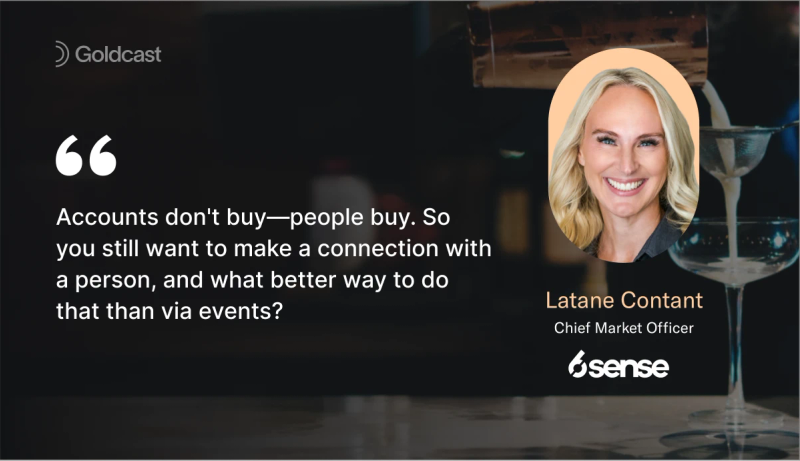ABM Expert Latané Conant of 6Sense Shares How to Build a Strong ABM Strategy

Table of Contents
Maximize Your Marketing ROI
Join 10,000 other marketers already getting the best tips on running engaging events that boost pipeline and create raving fans.
Just like your favorite cocktail, successful events benefit from the most tried-and-true recipes. For our fourth Sip & Share series, we gathered to learn how to mix some of the best tequila concoctions, as well as formulas for building a strong ABM strategy.
In this session, Belinda spoke with Latané Conant, the newly-minted Chief Revenue Officer (and former Chief Marketing Officer) of 6Sense, which bills itself as the only ABM platform powered by revenue AI.
Beyond being a marketing powerhouse, Latané recently authored a book, No Forms. No Spam. No Cold Calls: The next generation of account-based sales and marketing.
Obviously, we had to get Latané's insights around all things ABM!
Read on to learn:
- What is ABM?
- "Think of ABM like throwing a surprise party"
- Why ABM works
- How to tie events into your ABM strategy
- Enable your sales team to follow up quickly with the right accounts
- Measuring the success of your ABM efforts
- ABM frequently asked questions (FAQs)
📺 Watch the entire recording now, or keep scrolling to get the major event takeaways!

What is ABM?
We're seeing many marketers start to embrace ABM, but if you're new to the concept, let's define it first. In Latané's most basic terms, account-based marketing (ABM) is all about focusing on the most winnable accounts and contacts. Though the way you do that will evolve as things change, the core concept of focusing in on those accounts remains the same.
"Marrying the ease of creating pipeline and winning with customers vs the ability to keep and retain customers is the sweet spot of where you want to focus your entire GTM org." - Latané Conant, Chief Revenue Officer, 6sense.
ABM requires strategic planning. At 6sense, the team met to plot out all their different potential segments, all possible products, new personas they might sell to, and more. That helped them identify where the next wave of growth was coming from, as well as find the accounts they should be focusing on.
"Think of ABM like throwing a surprise party"
In early 2020, Latané wrote an article for Forbes that urged marketers to think about ABM like throwing a surprise party. You wouldn't throw a surprise party for just anyone, right? You'd have to know the person well enough to know where they're going to be, get them to the proper location, and make sure you have everything they like.
In our world, the people showing up with your guest of honor are the buying committee—you need to know who all of them are, and make sure they're all nurtured and engaged with! Having this level of knowledge about your target accounts is what differentiates a decent experience from an excellent one.
Why ABM works
6sense recently did a research study and three interesting facts emerged:
- Only 3% of the people that come to your website fill out a form. If you're only trying to connect with those people, you're missing out on 97% of your audience.
- Buying teams have increased in size by 30-40%. Marketers must be thinking now about they can speak to an entire buying committee instead of just one person. 6sense has found that the biggest difference between winning and losing an account is the number of engaged contacts—the higher, the better.
- The salesperson who gets into the account first wins 86% of the time.
So, what does all of this mean? Well, ABM strategies are great for making sure that you're proactively targeting the right accounts—not just waiting for them to come to your website. ABM also helps you progress your ops and include the entire buying team.
And the last point should signal a big push for your salespeople to be as proactive as possible and go after accounts! By the time a prospect is contacting you, they're probably contacting other companies as well. Reach out to them first!
"I don't want to work ops. I want to win ops." - Latané Conant, Chief Revenue Officer, 6sense
How to tie events into your ABM strategy
Events are the perfect opportunity to nurture and build key relationships.
"Accounts don't buy—people buy. So you still want to make a connection with a person, and what better way to do that than via events?" - Latané Conant, Chief Revenue Officer, 6sense

6sense hosts "lightning strike" events, which are huge undertakings that have 7-8 events within a larger offering. The company uses intent data to curate the content of the event, as well as the invite list and the post-event follow-up content.
While intent data can help you make sure you're reaching out to the right people, the team has been harnessing the power of generative AI to read, write, and respond to emails. The AI assistant uses the landing page for the event to write all of the emails and nurture the conversation to the point of registration and even after.
Another tactic 6sense uses is to decide on a big "revenue play" event that all departments will rally around. The revenue plays are led by the product marketing team and happen once per quarter, and everyone from BDRs to content folks to ABX gets involved. That's helped create some order out of the chaos in terms of events.

Enable your sales team to follow up quickly with the right accounts
After an event, timely followup is critical—the sooner you or your sales team can reach out, the better.
"The half-life after an event is like 12 hours. The rate of response starts to decay very quickly." - Latané Conant, Chief Revenue Officer, 6sense
But you also don't want to overload your sales team with too much info. At 6sense, their sales team is consolidated on one process, which is a 6sense qualified account or activity. Each day, the sales team gets the list of the highest-value accounts to work, whether that's the output of an event or a bunch of people showing intent.
The aim here is to make it as simple and straightforward for sales to do their jobs. Every Monday, Latané gets a report of unworked qualified accounts that she can follow up on. This keeps everyone aligned and on the same page as far as what to prioritize.
Measuring the success of your ABM efforts
Finally, how do you track and measure your ABM initiatives—particularly around events—to decide whether you're succeeding or not?
According to Latané, before you even launch a campaign, you must be clear on your business objectives. What are you trying to achieve? Are you trying to retain customers or upsell them? Do you want net new pipeline? Do you just want awareness?
From there, every campaign needs to follow five steps:
- Select the right accounts and contacts. Look at your objectives. If you want net new pipeline, for example, it wouldn't make sense to reach out to your existing customer base.
- Learn more about your target accounts. This goes back to the surprise party concept; you need to know as much as possible about your accounts to throw the right event for them!
- Engage your contacts in a way that speaks to them.
- Establish a follow-up process with sales and make sure they understand how they fit in. Remember the daily queue that the 6sense sales team can expect? Be clear on how sales fits into your process here.
- Track the stuff that matters to your business objective. 6sense just hosted their customer conference, Breakthrough, which is the largest line item in the entire marketing budget. The business objective for Breakthrough is ACV and retention; 6sense has a 100% renewal rate when an account comes to Breakthrough, so they want as many customers as possible to come!
Impressed by these tips? Don't forget to check out the full episode on demand to get all of Latané's expert insight!

ABM frequently asked questions (FAQs)
Q: How can you measure what specifically delivers the progress in pipeline?
A: The team at 6sense tracks every stage of the pipeline and the time in stage, as well as conversions by stage. They know everything they did directed toward each stage, and they look to see whether those activities reduced time in stage or increased progression. This can also help you identify any "dead zones" between stages and focus some ABM efforts there to keep people going.
Q: How important is it to invest in things that aren't always measurable?
A: Latané recently gave a presentation about the difference between the income statement and the balance sheet. Income statement investments generate immediate pipeline and revenue, while the balance sheet accounts for intangible assets or goodwill.
The difference between what someone would pay for your company and your actual revenue gets chalked up to goodwill. For marketers, this could be called "brand."
It's important to balance your investments between both your income statement and balance sheet. Things that build your customer community and affinity with your product are all balance sheet items that build your brand. While they could at some point boost your income statement, they're still incredibly important on their own.
Transform Your Video Marketing with AI
Stay In Touch
Platform
Resources
© 2025 Copyright Goldcast, Inc. All rights reserved.





 Upcoming Events
Upcoming Events Event Series
Event Series On-Demand Events
On-Demand Events

